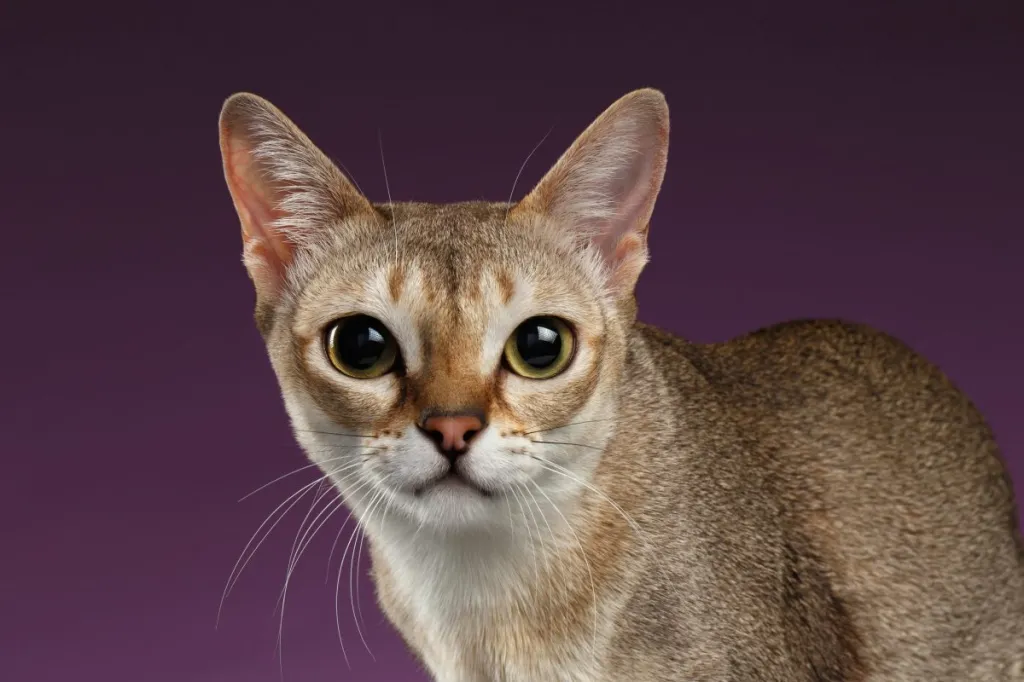The Singapura cat breed is a small and charming feline known for its distinctive appearance and affectionate personality. Originating from Singapore, these cats are one of the smallest domestic cat breeds, with adult females weighing around 4 to 6 pounds and males ranging from 6 to 8 pounds. Their coat is short and fine, featuring a warm, sepia-toned coloration with a unique pattern that resembles “ticking,” giving them a speckled appearance. What sets the Singapura apart are their large, expressive eyes, which contribute to their endearing and sweet expression.
In addition to their physical characteristics, Singapura cats showcase an affectionate and people-oriented nature. Additionally, they form strong bonds with their human companions. Despite their small size, they are energetic and playful with a curious and intelligent disposition. Singapuras often get along well with other pets and children, making them an excellent choice for families. Their vocalizations are soft and gentle, reflecting their social nature. They easily adapt to various living environments, thriving equally in apartments or houses.
When considering a Singapura, it’s advisable to prioritize adopting from rescue organizations or shelters to provide a loving home to a cat in need. However, if you decide to purchase, it’s crucial to choose a reputable breeder. It’s also important to conduct thorough research to ensure that the breeder follows ethical practices and prioritizes the well-being of their cats. Reputable Singapura breeders prioritize the health and temperament of their cats, conduct necessary health screenings, and provide a nurturing environment for the kitties. This active approach ensures that you bring home a healthy and happy kitty while discouraging unethical breeding practices.
Quick Facts
- Origin: Singapore
- Size: Small
- Breed Group: Shorthair
- Lifespan: 12-15 years
- Coat: Short, fine, and silky, with one coat color called sepia agouti
- Temperament: Intelligent, playful, and affectionate
- Exercise Needs: Moderate
- Training: Easy to train
- Grooming: Weekly brushing
- Health: Generally healthy
- While the Singapura is considered a purebred cat, there is speculation that the Singapura is a cross between a Burmese and Abyssinian.
- The Singapura is considered one of the smallest domestic cats.
- The Singapura is called the Kucinta in Malay.
- The coat color of a Singapura cat is called sepia agouti.
Singapura Pictures
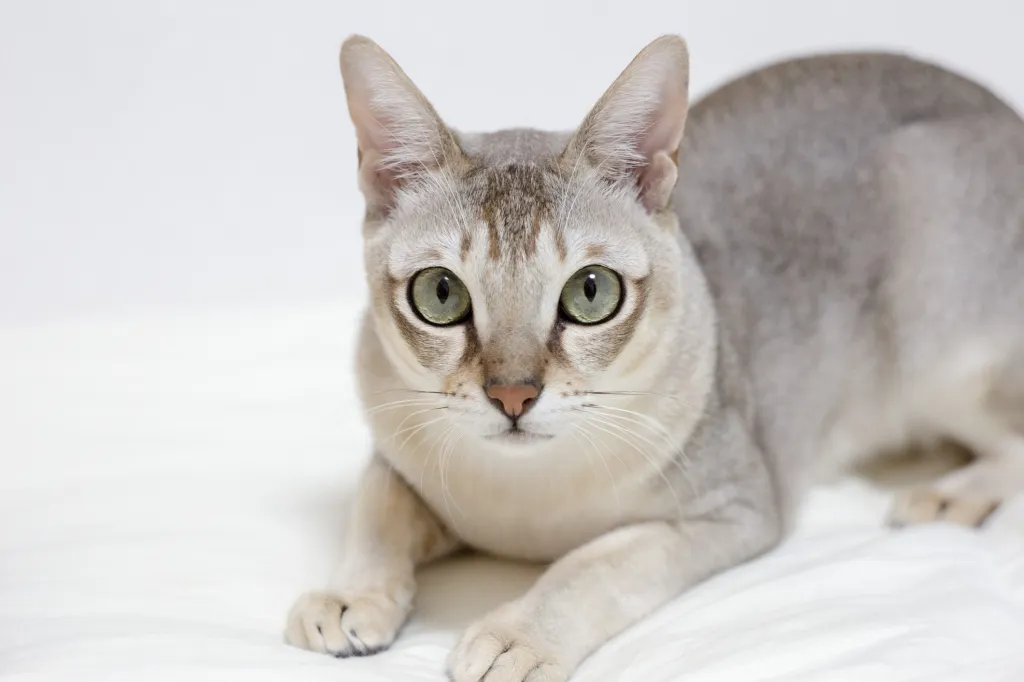
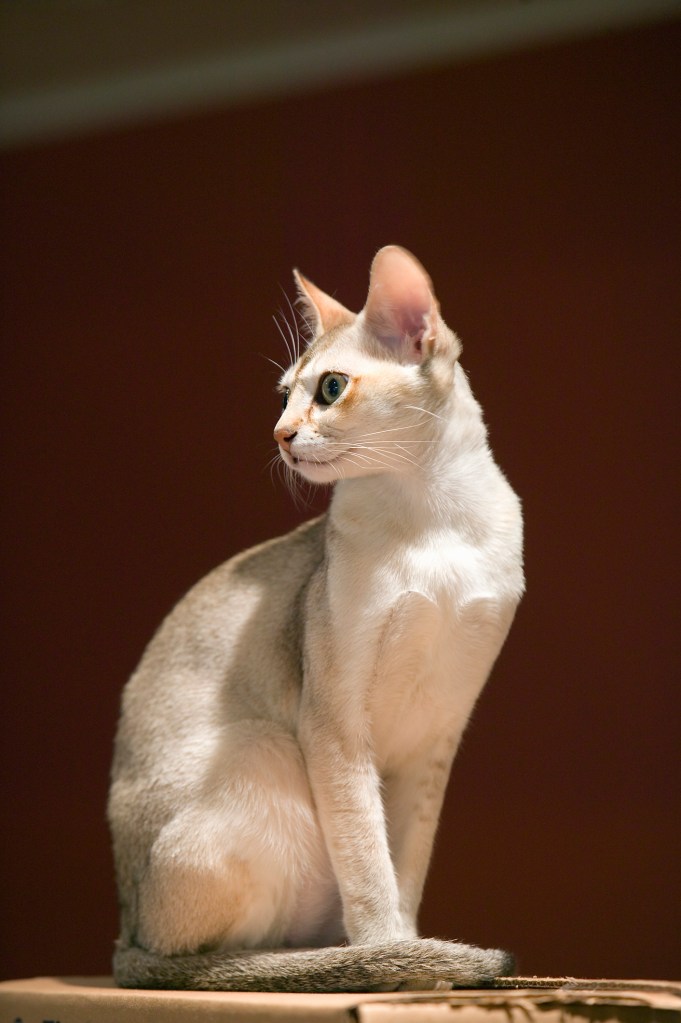
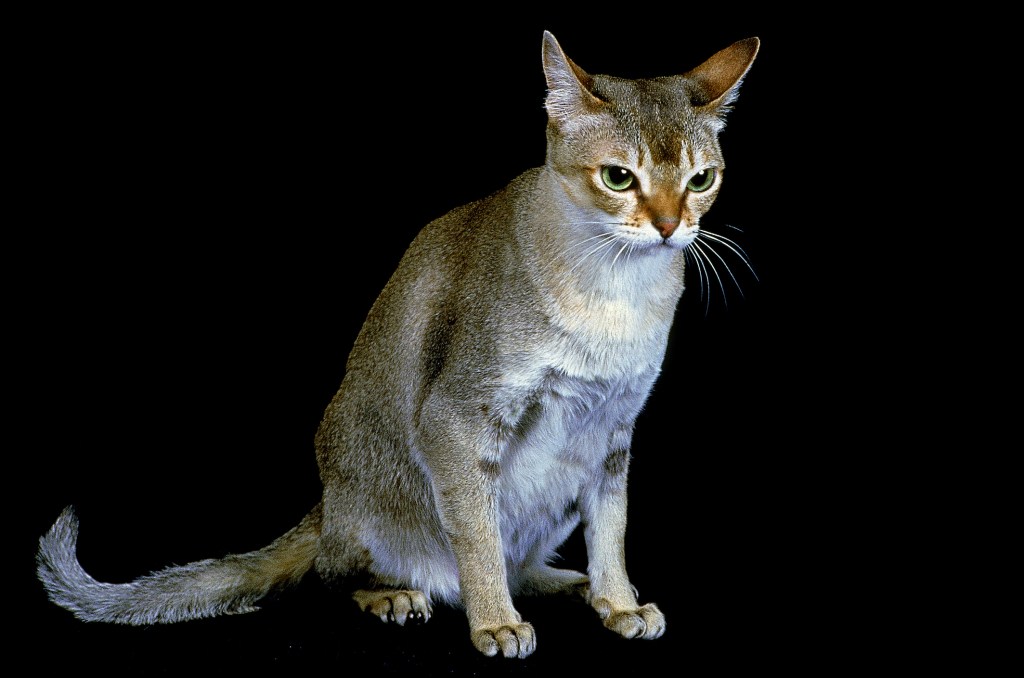
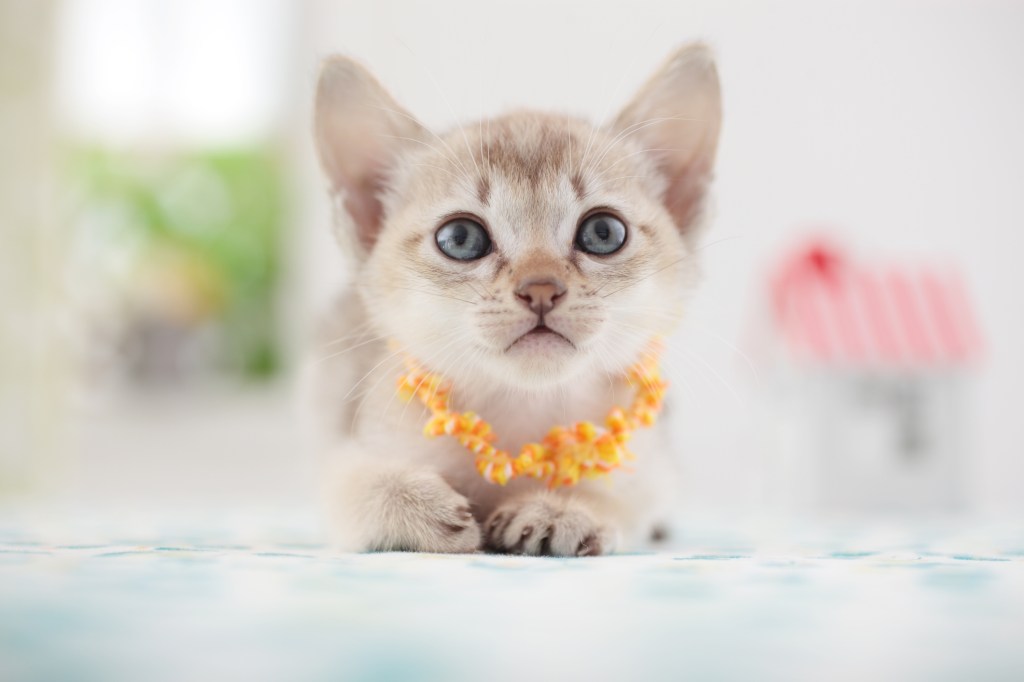
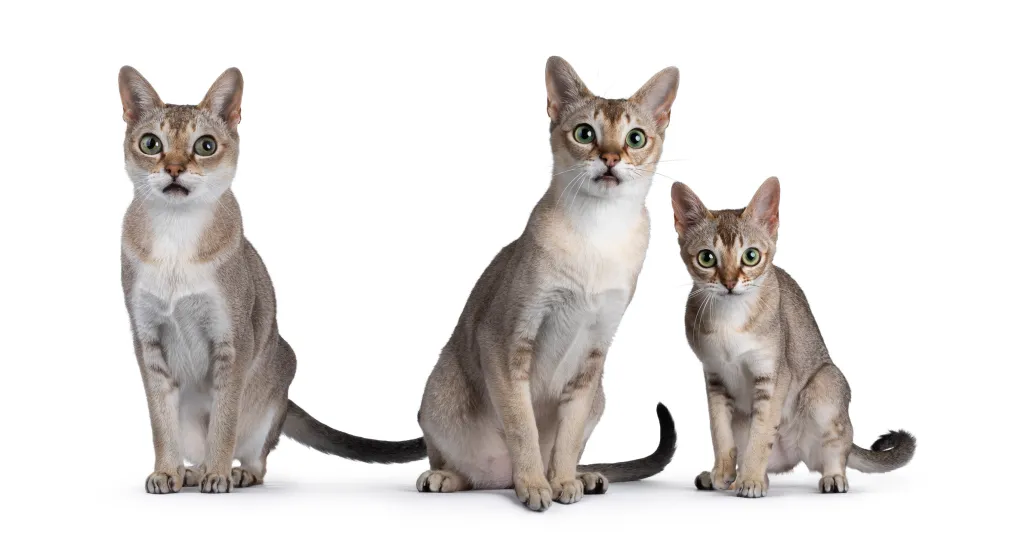
-
Affectionate with Family
Some cat breeds are typically independent and aloof, even if they’ve been raised by the same person since kittenhood; others bond closely to one person and are indifferent to everyone else; and some shower the whole family with affection. Breed isn’t the only factor that goes into affection levels; cats who were raised inside a home with people around feel more comfortable with humans and bond more easily.

See Cats Less Affectionate with Family -
Amount of Shedding
If you’re going to share your home with a cat, you’ll need to deal with some level of cat hair on your clothes and in your house. However, shedding does vary among the breeds. If you’re a neatnik, you’ll need to either pick a low-shedding breed or relax your standards. This furniture cover can make it easier to clean up cat hair and keep it off your sofa!
-
General Health
Due to poor breeding practices, some breeds are prone to certain genetic health problems. This doesn’t mean that every cat of that breed will develop those diseases; it just means that they’re at an increased risk. If you’re looking only for purebred cats or kittens, it’s a good idea to find out which genetic illnesses are common to the breed you’re interested in.
-
Potential for Playfulness
Some cats are perpetual kittens—full of energy and mischief—while others are more serious and sedate. Although a playful kitten sounds endearing, consider how many games of chase the mouse-toy you want to play each day, and whether you have kids or other animals who can stand in as playmates. A classic wand cat toy like this one is perfect for playful felines!
-
Tendency to Vocalize
Some breeds sound off more often than others with meows, yowls, and chattering. When choosing a breed, think about how the cat vocalizes and how often. If constant “conversation” drives you crazy, consider a kitty less likely to chat.
-
Kid-Friendly
Being tolerant of children, sturdy enough to handle the heavy-handed pets and hugs they can dish out, and having a nonchalant attitude toward running, screaming youngsters are all traits that make a kid-friendly cat. Our ratings are generalizations, and they’re not a guarantee of how any breed or individual cat will behave; cats from any breed can be good with children based on their past experiences and personality.
-
Friendly Toward Strangers
Stranger-friendly cats will greet guests with a curious glance or a playful approach; others are shy or indifferent, perhaps even hiding under furniture or skedaddling to another room. However, no matter what the breed, a cat who was exposed to lots of different types, ages, sizes, and shapes of people as a kitten will respond better to strangers as an adult.
-
Easy to Groom
Some breeds require very little in the way of grooming; others require regular brushing to stay clean and healthy. Consider whether you have the time and patience for a cat who needs daily brushing. You should definitely pick up this awesome de-shedding tool for cats of any hair length!
-
Intelligence
Some cat breeds are reputed to be smarter than others. But all cats, if deprived the mental stimulation they need, will make their own busy work. Interactive cat toys are a good way to give a cat a brain workout and keep them out of mischief. This scratcher cat toy can keep your smart kitty busy even when you’re not home!
-
Pet Friendly
Friendliness toward other household animals and friendliness toward humans are two completely different things. Some cats are more likely than others to be accepting of other pets in the home.
Singapura History
The Singapura was developed in the 1970s from cats found in Singapore — the Lion City — by cat fanciers Hal and Tommy Meadow. Their cats Ticle, Pusse, Tes, George and Gladys, plus Chiko, adopted later from a shelter in Singapore, were the foundation of the pedigreed Singapura, although cats like them had probably lived in Southeast Asia for at least a decade if not longer.
Brown cats and cats with agouti, or ticked, coats are common in the region, and there is likely some relationship to Siamese and Burmese cats. The ticked tabby gene is dominant to all other tabby patterns and is frequently seen in Southeast Asian cats. Small cats with a brown-ticked coat were known in Singapore from at least 1965.
The Singapura as discovered by the Meadows may have resulted from matings between cats with the Abyssinian ticked tabby gene and the Burmese gene (which gave the brown color). A DNA study published in 2008 showed little to no difference genetically between the Burmese and the Singapura. The Cat Fanciers Association recognized the breed in 1988, and it is also recognized by most other cat associations. In 1990, the Singapore Tourist Promotion Board adopted the Singapura as the island nation’s travel mascot.
Singapura Size
The Singapura weighs 4 to 8 pounds.
Singapura Personality
The tiny Singapura has a tiny little voice, but this mischievous and active cat makes his presence known in other ways: chasing small balls down the hall, tapdancing on keyboards, climbing curtains or anything else that will place him on high, or jumping on your shoulder as you walk by to go for a ride. He retains his playfulness well into adulthood.
The Singapura loves people and isn’t shy about meeting people. He likes being a lap cat and is an excellent bedwarmer on cold winter nights. Despite his busy nature, he is a gentle friend who will put aside his activities to keep you company when you’re feeling under the weather.
The rest of the time? Watch out — he is as curious as cats come and will be into anything that looks interesting. The Singapura does best in a home where he will have plenty of company — human or animal.
Singapura Health
Both pedigreed cats and mixed-breed cats have varying incidences of health problems that may be genetic in nature. Singapuras are generally healthy, but one problem that might occur in the breed is:
- Pyruvate Kinase Deficiency: Known as PKD for short (not to be confused with polycystic kidney disease in Persians), the inherited genetic disease is caused by a deficiency of an enzyme important for red blood cell energy metabolism and results in hemolytic anemia. A test is available that can determine whether a cat is affected, a carrier, or clear of the disease. Fortunately, Singapuras with PKD can usually live a normal life.
Singapura Care
The Singapura’s short, smooth coat is easy to care for with a quick weekly combing. Polishing it with a chamois will make it shine. A bath is rarely necessary. Brush the teeth to prevent periodontal disease. Daily dental hygiene is best, but weekly brushing is better than nothing. Trim the nails every couple of weeks. Wipe the corners of the eyes with a soft, damp cloth to remove any discharge. Use a separate area of the cloth for each eye so you don’t run the risk of spreading any infection.
Check the ears weekly. If they look dirty, wipe them out with a cotton ball or soft damp cloth moistened with a 50-50 mixture of cider vinegar and warm water. Avoid using cotton swabs, which can damage the interior of the ear. Keep the litter box spotlessly clean. Cats are very particular about bathroom hygiene.
It’s a good idea to keep a Singapura as an indoor-only cat to protect him from diseases spread by other cats, attacks by dogs or coyotes, and the other dangers that face cats who go outdoors, such as being hit by a car. Singapuras who go outdoors also run the risk of being stolen by someone who would like to have such a beautiful cat without paying for it.
Singapura Coat Color And Grooming
The Singapura has three distinguishing characteristics: his small size of 4 to 8 pounds, big eyes and ears for his size, and his sepia-toned coat that gives him the look of having stepped out of a 19th-century photograph. The short, fine coat has a silky texture. Its color is called sepia agouti, described as dark-brown ticking on a background color that resembles warm old ivory. Each hair has at least two bands of dark ticking separated by light bands, ending with a dark tip. The fur on the muzzle, chin, chest and belly are the color of unbleached muslin.
On the face, the Singapura looks as if he’s been playing in the makeup box, with dark lines extending from his brows and the outside corners of his hazel, green or yellow eyes, dark lines extending downward from the inner corner of the eyes along the bridge of the nose — called cheetah lines — and dark brown lines around the eyes, lips and nose.
In contrast, his nose leather is a pale to dark salmon color, and his paw pads are rosy brown. The Singapura may be small, but he’s by no means delicate. His body is stocky and muscular, and his neck is short and thick. Heavily muscled legs taper to small, short, oval feet. His tail is short and slender with a dark tip.
Children And Other Pets
The Singapura is playful and smart and can be a good friend to a child who treats him nicely. He’s one of those cats who enjoys playing fetch and learning tricks, and his energy level means he won’t wear out before the child does. He is happy to live with other cats and cat-friendly dogs, too, thanks to his amiable disposition.
Introduce pets slowly and in controlled circumstances to ensure that they learn to get along together. Singapuras usually get along well with other animals and seem to prefer living with some kind of company, not thriving when left alone all day.
Singapura Rescue Groups
More Info For You
If you’re also looking for a dog, check out DogTime’s dog breed page!
